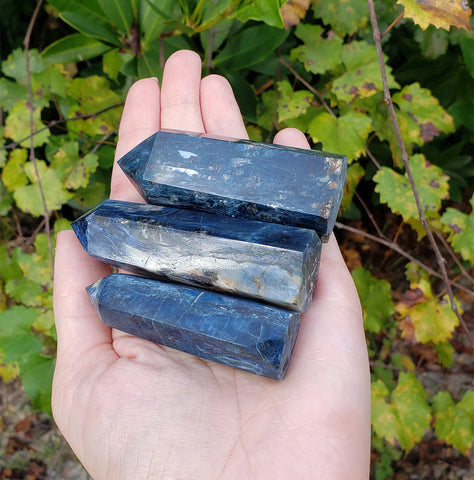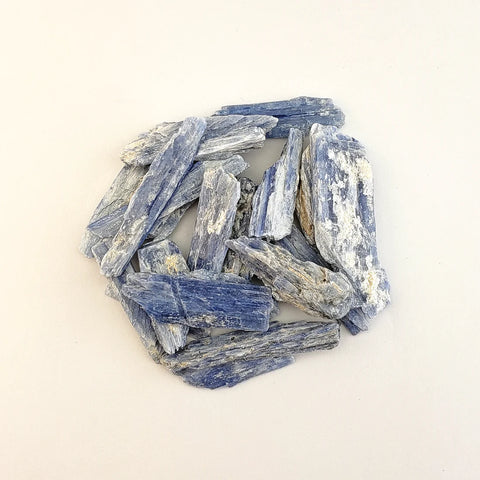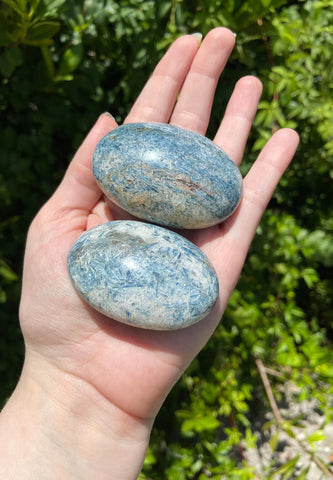Kyanite Meaning
A guide for the history, meaning, and properties of Kyanite. Stone for..
Repelling Negativity | Meditation | Discovery
Kyanite Meaning
Some say that a Kyanite crystal is like a great blue blade that can cut through negativity, and they believe that when this sword is drawn, one will be able to enter a deeper meditation.
Why a blade? Well, kyanite is typically found in a blade-like pattern when it forms. It is not typically put into jewelry; in particular, it is rare to see it faceted. It is because of its unique formation that many prefer kyanite in its raw form, as it has a pretty cool structure.
Throughout history, kyanite has been known as "Cyanite" and as "Disthene." Today, both of these terms are considered archaic. While kyanite is most-often blue, it can appear in other colors, such as white, grey, black, or even orange. Most of these, however, are rare, including green kyanite.
Blue kyanite is the standard appearance, and most of the metaphysical properties referenced here are in that context. Even blue kyanite is likely to have a little black or green sprinkled in. But many of these properties can apply to the other shades as well.

A kyanite crystal has quite a bit of variety in its hardness, as it can range from ~5-7 on Mohs scale; this depends on the axis one scratches it. Kyanite is rarely cut for jewelry; aside from the general preference for its thin, blade-like formation, kyanite is not a particularly brilliant stone. In our experience, kyanite jewelry is often natural or raw, which preserves its much beloved formation. This might change, however, as some are looking into certain specimens from India as a potential source for quality amethyst that is suitable for jewelry.
Despite this, some people may use cut kyanite as a substitute for sapphire. Some might do so in a deceptive manner, but others merely like kyanite for its beautiful blue color. However, kyanite isn't as brilliant as sapphire, so this likely won't fool the trained eye. Both are very different stones, so someone who looks a little closely will likely be able to spot the fake if someone is trying to be rather dishonest about their intentions.
While polished kyanite might not have much use in jewelry, these little crystals are frequently used in certain industries. For instance, many refractory products and porcelains use kyanite due to its properties. Thankfully, kyanite is a relatively common stone.
Many believe kyanite can cut through and filter energy as necessary, though they say it is not a great medium for storing energy. Some say kyanite also makes for a good blockage buster stone.
During meditation, some believe that they can dive deep with kyanite, especially when getting in tune with their Crown & Throat Chakras.
Meditation enthusiasts and individuals interested in mindfulness often seek effective methods to enhance their meditation experience. One such method, popular among crystal healers and meditation practitioners, is the use of isochronic tones.
Isochronic tones are distinct auditory pulses that are believed to potentially aid in quieting the mind, especially for those who face challenges in silencing intrusive thoughts during meditation. According to practitioners, these tones work by encouraging certain areas of the brain to align with the introduced rhythmic patterns, thereby creating a harmonious mental state conducive to meditation.
The practice of integrating isochronic tones into meditation sessions is believed by some to facilitate the development of individual psychic abilities. Adherents claim that by reducing mental chatter and achieving deeper meditative states, individuals may find it easier to tap into their personal psychic potential.

Crystal healers and meditation guides often suggest that even short durations of meditation with isochronic tones can offer benefits. These include improved focus, enhanced relaxation, and a deeper exploration of one's innate abilities and gifts. However, as with any alternative meditation technique, it's recommended to approach these practices with an open mind and a critical perspective.
In summary, while the use of isochronic tones in meditation is a subject of interest within certain spiritual circles, it's essential for individuals to approach this practice with an understanding that its purported benefits are based on personal beliefs rather than scientific evidence. For those interested in exploring meditation and mindfulness, incorporating isochronic tones can be an intriguing addition to their practice, provided it's done with awareness of its anecdotal nature However, it's crucial to understand that this is a belief held within certain spiritual communities and is not confirmed by scientific research.
In the realm of crystal healing, which is based on spiritual beliefs rather than scientific evidence, blue Kyanite is often celebrated for its potential in enhancing psychic hearing or clairaudience. It is important to note that these claims are not supported by scientific research, but are based on the traditions and beliefs within the crystal healing community.
Blue Kyanite is said to harmonize well with a variety of high vibration stones, believed by enthusiasts to synergistically enhance psychic abilities. For those interested in exploring this aspect of crystal healing, consider pairing blue Kyanite with other crystals such as Natrolite, Phenacite, Libyan Desert Glass, or Moldavite. These combinations are thought to work in concert, potentially amplifying clairaudient abilities.
Crystal enthusiasts often encourage trying different combinations of these stones to find what personally feels most effective. It's a journey of personal exploration, understanding that experiences and results can vary greatly among individuals.
In conclusion, while the use of blue Kyanite and other crystals in enhancing clairaudience is a popular concept within certain spiritual circles, it is essential to approach these practices with an awareness that their effectiveness is based on personal beliefs and anecdotal experiences, not scientific validation. For those drawn to the world of crystal healing, experimenting with these stones can be an intriguing and personal journey into the exploration of potential psychic abilities.

Kyanite is a bluish mineral with high aluminum content. Kyanite has properties that make it important in the manufacturing of some materials, including glass and glass kilns, ceramics, electricity, and chemicals. It has the ability to strengthen tiles and ceramics. Despite making up a fraction of the product of refractories, the mineral is vital for some industries. About half of all kyanite refractory produced is used in the metallurgy industry alone.
Since kyanite is said to merely filter energy and not store it, some use this stone to clear spiritual blockages. Some believe that kyanite is a stone that can help them find inner confidence, and so they will keep the stone close for when they need to build courage for something like public speaking or performance.
Even if you do not believe that kyanite is a stone with metaphysical powers, it's hard to deny that it is a unique stone. Its standout appearance has led to it being a common choice for crystal decor, and some even doubt that the stone truly forms like that. However, if you spend a lot of time with crystals, you would surely know that some stones really are strange like that. It's one of our favorite parts about working with minerals. You never know what you'll find in our vast and strange world.
Orange kyanite is a peculiar type of kyanite that, thus far, has only been found in Tanzania. It is a beautiful and unique, so unsurprisingly this somewhat exotic choice has lent it to being a top-choice among certain sellers when they have it in store.
Scientific Information
Name Variation: Cyanite: this is an infrequent term and is archaic in English.
Disthene is another term for Kyanite. This is also archaic.
Kyanite Pronunciation: /kaɪənaɪt/ (k-eye-uh-night)
Kyanite Misspellings: Kianite, Kyanit
Hardness: 5-7
Lustre: Vitreous
Crystal System: Triclinic
Etymology: Named after the Greek word for blue, “kyanos”
Location: Global
The Wrap Up
We hope that this blog has been of some use to those who want to learn about this wonderful gemstone. Kyanite is a crystal with a unique blade-like formation, which makes it ideal for those who like boho decor or aesthetics. While blue kyanite is probably the most commonly owned, green kyanite is another variety that collectors opt for.
Kyanite is not considered a prime choice for jewelry by any means, but it has many practical uses in various industries, which is something that can be easily overlooked, unfortunately. In any case, we are glad to have kyanite in our store, and we thank you for reading!

Click Here To See Our Kyanite Collection
Browning, James S., and Bennett, Paul E.. Beneficiation of Georgia Kyanite Ore. United States, U.S. Department of Interior, Bureau of Mines, 1970.
Jensen, Nan C.. Marketing Kyanite and Allied Minerals. United States, United States Department of the Interior, Bureau of Mines, 1943.
Kozminsky, Isidore. The Magic and Science of Jewels and Sones. United States. Knickerbocker Press, 1922.
https://www.gemsociety.org/article/kyanite-jewelry-and-gemstone-information/
https://www.gia.edu/gems-gemology/spring-2014-gemnews-indian-pradat-kyanite
"Electronic absorption and luminescence spectroscopic studies of kyanite single crystals" by A. N. Platonov, A. N. Tarashchan, K. Langer, M. Andrut, G. Partzsch & S. S. Matsyuk.
https://geology.com/minerals/kyanite.shtml
